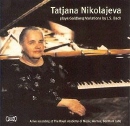|
Goldberg Variations BWV 988
Tatiana Nikolayeva (Piano)
Another Goldberg Variations From Nikolayeva
|
K-7 |
Tatjana Nikolajeva plays Goldberg Variations by J.S. Bach |

|
|
Goldberg Variations BWV 988 [70:51]
Chorale 'Jesu bleibet meine Freude' (Mvt. 10) from Cantata BWV 147 [3:36] |
|
Tatiana Nikolayeva (Piano) |
|
Classico |
Apr 1983 |
CD / TT: 74:27 |
|
3rd recording of Goldberg Variations BWV 988 by T. Nikolayeva. Recorded Live at Royal Academy of Music, Aarhus, Denmark.
Buy this album at: Amazon.com |
|
Donald Satz wrote (November 11, 2004):
Goldberg Variations Comparison: Nikolayeva/Hyperion (rec. 1992 - 79:38)
Performer: Tatiana Nikolayeva (1924-1993) is one of the great Russian pianists of the 20th century. Highly regarded for her Bach and Beethoven, her crowning achievement on record is her three recordings of the Shostakovich Op. 87 Preludes and Fugues. Nikolayeva is definitive in this repertoire, no doubt helped by her friendship with Shostakovich and the fact that she was the champion for getting the Soviet authorities to allow publication of Op. 87 by actually playing the music for those undeserving but lucky bureaucrats.
Genesis of Recording: Nikolayeva was holding master classes in April 1983 at the Royal Academy of Music in Aarhus. On the last work day, she gave a concert of Bach's Goldberg Variations and an encore from BWV 147. Although the concert was taped, copyright and other issues would not allow that a recording be made for distribution. Eventually, Sergei Senkov, a Nikolayeva student, tracked down her son and secured the permission to make the performance available to the public. I have no idea how CLASSICO ended up releasing the disc, but it is certainly is a feather in the company's hat.
1983 vs. 1992: With the release of the 1983 live performance, the 1992 Hyperion disc can be safely retired. The fact is that Nikolayeva's technical prowess was in decline by 1992, and she definitely sounds challenged in the fastest variations. Further, she is more vibrant in the live performance, and her frequent changes in tempo and dynamics have a more natural flow than on the Hyperion where they sound slightly contrived with a choppy demeanor. Concerning sound quality, the Classico sound is more open although there is a brittle element to notes from the upper voices. So, let's just put the Hyperion to rest with a three-gun salute.
Other Performance Characteristics: The dominant trait of the interpretation is 'insistence'. Nikolayeva rarely relaxes, always at the ready to pounce on notes and phrases. Some might feel that she hectors her listeners, but this reviewer feels that the insistence is delivered in a compelling fashion and represents an overall advantage for the performances. As for repeats, Nikolayeva observes most of them.
Specific Variations: Nikolayeva does begin with a very comforting and warm Aria, one of the best on record. I suggest listeners luxuriate in the security, because there isn't much more of it as the performance progresses.
The insistent and pointed articulation of Nikolayeva's interpretive stance is most noticeable in Variations 4, 8, 12, 27, 29, and 30. In Variation 8, it sounds as if steam is coming out of her ears and nostrils. Nikolayeva is a woman who doesn't take 'no' for an answer, conveying an inner strength equal to any other versions on the market.
Variation 6 is outstanding as Nikolayeva aligns her regiment of changing tempo and dynamics with with the up-down rhythmic flow from both upper and lower voices. As for exuberance, just listen to her playing of the first three Variations; the high energy figuratively leaps out of the speakers.
The emotion of despair is also superbly caught by Nikolayeva in Variations 15, 21, and 25. It is almost painful to listen to, and No. 25 (Black Pearl) conveys a 'black hole' where all hope is crushed.
Don's Conclusions: Certainly one of the better versions of the Goldberg Variations to be found. As I mentioned earlier, some listeners might feel hammered by Nikolayeva, but nobody will leave unaffected by her highly individualized readings. Of course, there are many other exceptional piano versions including three from Glenn Gould on Sony, two from Rosalyn Tureck on Deutsche Grammophon and Philips respectively, and single efforts from Andras Schiff on ECM and Charles Rosen on Sony; I do recommend passing on the earlier Schiff version on Decca. With many additional superb accounts on harpsichord, we are in a golden age concerning the greatest variation work in the illustrious history of classical music. Do not delay - acquire some of these sensational recordings. |
| |
|